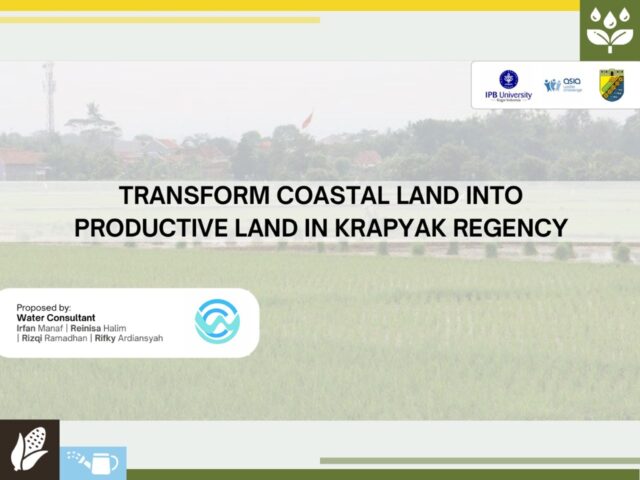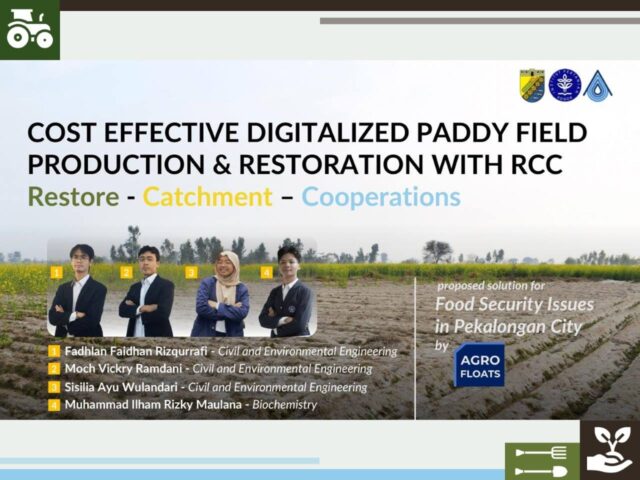Pantura Region and Its Significance

Figure 1. Pantura Route Map (source: Wikipedia)
The Pantura Region (Pantai Utara, or North Coast of Java) in Indonesia is a critical economic artery that contributes 20.7% to the nation’s Gross Domestic Product (GDP) and is home to over 50 million people[1]. The 1,300+ kilometers route of Pantura passes through Banten, Jakarta, West Java, Central Java, and East Java, connecting several key agricultural regions essential for food production. Under President Prabowo Subianto’s leadership, achieving food self-sufficiency and stabilising the regional economy has become a national priority, highlighting the strategic significance of the Pantura region.
However, food production in the Pantura region has been facing critical threats from environmental and climate challenges. The region is experiencing land subsidence at rates of 5-10 cm per year and a sea level rise of 3-10 mm annually[2]. These phenomena consequently affect food productivity and economic activities, with estimates projecting a potential 4.9% reduction in national GDP growth and economic losses of IDR 6,607 trillion by 2045 if no action is taken[1].
Pekalongan City’s Coastal Agricultural Challenges

Figure 2. Pekalongan City (source: Wikipedia/Nararya Danuwijaya)
In Pekalongan City, one of the cities located in the Pantura Region, the urgency of intervention becomes even more apparent. The city suffered from a significant food deficit of almost 20,000 tons in 2022, with the city’s overall food availability standing at just 4,602 tons and demand reaching 23,355 tons[3]. The rice production in the city can only cover 10% of its total demand, with the remaining 90% supplied by local trades from nearby cities and regencies. One of the reasons is that irrigated rice fields are increasingly being impacted by seawater intrusion, turning once-productive land into idle areas[3]. The decline in rice harvest yields is also a direct result of tidal flooding and substantial land subsidence[3].

Figure 3. A local farmer working in a rice field5
For years, around 100 hectares of agricultural land were inundated by tidal flooding. These areas only recently became dry again after flood and tidal management structures were built in 2023. The local government is now attempting to reclaim the empty land for agriculture, starting with a 5-hectare pilot project in the Krapyak subdistrict. By November 2024, the government had cultivated and harvested 1.2 hectares of the pilot area, though the yield was not optimal, yet. Based on The Water Agency’s visit to Pekalongan City, they are facing challenges due to soil salinity. The decreasing rainfall events and the polluted river, which serves as the irrigation source, have led to a decline in clean freshwater availability and further complicating the land revitalization efforts.
On the socio-economic side, Pekalongan’s agriculture sector also suffers from challenges related to human resources. The number of farmers has declined significantly, from 58 farmers’ groups to only 28 in 2019[4]. The local government is also concerned about the decreasing number of young farmers, which threatens both regeneration and future food productivity. Without significant technological improvements and supportive policies, sustainable food production in the city will remain a distant goal.
Water for Food Youth Challenge: Building Resilient Coastal Agriculture in Pekalongan
Given the complex water and socio-economic challenges in the Pekalongan City’s agriculture sector, the participants of the Water for Food Youth Challenge are tasked to explore and develop innovative water solutions, aiming to transform the vacant land—the land previously flooded by tidal waters for years—into a productive agricultural area.
Don’t forget to register your team/yourself before 9th December through this link: bit.ly/WaterForFoodChallenge
See you very soon!
References:
- Limanseto, H. (2024, September 28). Bekerja Sama dengan Korea Selatan dan Belanda, Pemerintah Susun Strategi Perlindungan dan Pembangunan Berkelanjutan Pantura Jawa. Kementerian Koordinator Bidang Perekonomian Republik Indonesia. Retrieved from: https://www.ekon.go.id/publikasi/detail/5985/bekerja-sama-dengan-korea-selatan-dan-belanda-pemerintah-susun-strategi-perlindungan-dan-pembangunan-berkelanjutan-pantura-jawa
- Humas BRIN. (2024, January 11). Hati-Hati Ancaman Amblesan Tanah Pantura sebagai Silent Hazard, Ini Kota-Kota yang Rawan Terdampak. Badan Riset dan Inovasi Nasional. Retrieved from: https://www.brin.go.id/news/117310/hati-hati-ancaman-amblesan-tanah-pantura-sebagai-silent-hazard-ini-kota-kota-yang-rawan-terdampak
- Peraturan Daerah Kota Pekalongan tentang Rencana Pembangunan Jangka Panjang Daerah (RPJPD) Kota Pekalongan Tahun 2025-2045. Retrieved from: https://bappeda.pekalongankota.go.id/web/storage/2025/Panjang/Perda%20RPJPD%20Kota%20Pekalongan%20Tahun%202025-2045.pdf
- Ella – Regina. (2019, June 26). Dinperpa Prihatin, Petani di Kota Pekalongan Semakin Berkurang. Radio Kota Batik Pekalongan. Retrieved from: https://rkb.pekalongankota.go.id/berita10557-1-dinperpa-prihatin-petani-di-kota-pekalongan-semakin-berkurang-.html
- Pemerintah Kota Pekalongan. (2021). [Photograph of a local farmer working in a rice field in Pekalongan City]. Retrieved from: https://pekalongankota.go.id/berita/dinperpa-pantau-banjir-lahan-pertanian.html





